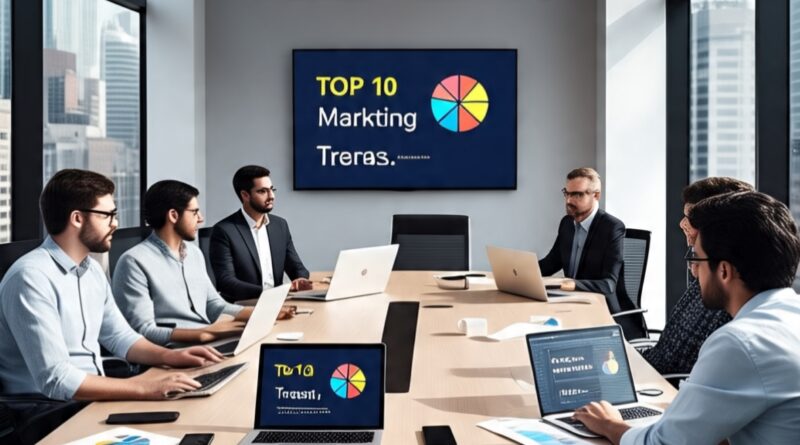Top 10 Digital Marketing Trends, you Need To Know.
The digital marketing landscape is constantly evolving. What worked yesterday may not be effective today, and staying ahead of the curve is essential for brands, marketers, and businesses that want to thrive online.
As we progress through 2025, new technologies, shifting user behaviors, and algorithm updates continue to shape the way businesses market themselves.
To help you stay updated, here are the top 10 digital marketing trends you need to know:
1. AI-Powered Content.
Creation and Personalization**
Artificial Intelligence is no longer a futuristic concept; it’s shaping content marketing in real time. Tools like ChatGPT and other AI platforms are enabling businesses to generate content, automate customer responses, and personalize experiences at scale. Whether it’s product descriptions, email sequences, or blog posts, AI is making it faster and more efficient.
AI also allows marketers to analyze data and offer personalized product recommendations, making users feel seen and understood resulting in better conversion rate.
2. Voice Search Optimization
With the rise of smart speakers and voice assistants like Alexa, Siri, and Google Assistant, voice search is becoming mainstream. Optimizing your website for voice search using natural language, question-based queries, and featured snippets can help you capture a broader audience.
Expect more businesses to invest in voice-friendly SEO, especially for local searches like “best coffee shop near me.”
3. Video Marketing Dominance.
Video content continues to dominate social media and websites. Short-form videos (like those on TikTok, Instagram Reels, and YouTube Shorts) are particularly popular, engaging audiences quickly and effectively.
Brands are using video to showcase products, share tutorials, go behind the scenes, or simply entertain their audience.
In 2025, live streaming and interactive video content are also on the rise, offering real-time engagement opportunities with viewers
4. Social Commerce Expansion.
Social media is no longer just a branding tool—it’s now a full-fledged sales channel. Platforms like Instagram, Facebook, TikTok, and even Pinterest have integrated shopping features, allowing users to discover and buy products without leaving the app.
This trend, known as social commerce, is especially effective when combined with influencer marketing.
It makes the buying journey seamless and helps brands reach customers where they spend most of their time.
5. Influencer Marketing 2.0
Influencer marketing isn’t going anywhere, but it’s evolving.
Micro and nano influencers (with smaller but highly engaged audiences) are becoming more popular as they offer better ROI and authenticity compared to big-name celebrities.
In 2025, brands are focusing more on long-term partnerships and niche collaborations, rather than one-time promotions.
This helps create trust and builds lasting relationships with the audience.
6. Privacy-First Marketing.
As consumers become more privacy-conscious and regulations like GDPR and CCPA tighten, marketers must adopt a privacy-first approach.
The phasing out of third-party cookies has forced businesses to rely more on first-party data (data collected directly from users).
This means marketers need to prioritize building trust, being transparent about data collection, and encouraging users to opt-in through value-driven content or offers.
7. Interactive Content.
Static content is taking a backseat. In 2025, interactive content like polls, quizzes, sliders, and interactive infographics is being used to boost engagement and gather user insights.
This kind of content not only increases the time users spend on your site or social media pages but also helps you understand their preferences better, leading to more personalized marketing.
8. Visual and Voice Search Integration.
Beyond just voice search, visual search is also becoming a game-changer.
Tools like Google Lens and Pinterest Lens allow users to search for products using images. This is especially useful in e-commerce, where users can snap a photo of something they like and find similar products instantly.
Brands that optimize their images with proper alt text, structured data, and high-quality visuals are more likely to show up in visual search results.
9. User-Generated Content (UGC) for Authenticity
UGC continues to be a trusted form of content, whether it’s customer reviews, testimonials, photos, or videos shared by real users.
It builds trust and encourages others to engage or purchase because it’s authentic and relatable.
Encouraging your audience to share their experiences with your product or brand (and resharing it) is a powerful strategy to enhance credibility and social proof.
10. Marketing Automation and CRM Integration.
Automation is helping marketers do more with less. From email marketing and lead nurturing to retargeting ads and social media scheduling, automation tools are streamlining repetitive tasks and improving productivity.
When integrated with Customer Relationship Management (CRM) systems, businesses can track customer journeys, segment audiences better, and deliver personalized campaigns with greater accuracy.
Final Thoughts.
Digital marketing is no longer a one-size-fits-all strategy.
As technology evolves and user expectations grow, marketers must stay agile and adopt the latest trends to remain competitive.
From AI-powered tools to voice and visual search, every trend mentioned above offers opportunities to engage customers more effectively and drive business growth.
Embrace these trends, test them out, and stay flexible. The brands that adapt fastest will be the ones leading tomorrow’s digital frontier.

